The Intel Xeon W-3175X Review: 28 Unlocked Cores, $2999
by Ian Cutress on January 30, 2019 9:00 AM ESTCPU Performance: Rendering Tests
Rendering is often a key target for processor workloads, lending itself to a professional environment. It comes in different formats as well, from 3D rendering through rasterization, such as games, or by ray tracing, and invokes the ability of the software to manage meshes, textures, collisions, aliasing, physics (in animations), and discarding unnecessary work. Most renderers offer CPU code paths, while a few use GPUs and select environments use FPGAs or dedicated ASICs. For big studios however, CPUs are still the hardware of choice.
All of our benchmark results can also be found in our benchmark engine, Bench.
For our graphs, some of them have two values: a regular value in orange, and one in red called 'Intel Spec'. ASUS offers the option to 'open up' the power and current limits of the chip, so the CPU is still running at the same frequency but is not throttled. Despite Intel saying that they recommend 'Intel Spec', the system they sent to us to test was actually set up with the power limits opened up, and the results they provided for us to compare to internally also correlated with that setting. As a result, we're providing both sets results for our CPU tests.
Corona 1.3: Performance Render
An advanced performance based renderer for software such as 3ds Max and Cinema 4D, the Corona benchmark renders a generated scene as a standard under its 1.3 software version. Normally the GUI implementation of the benchmark shows the scene being built, and allows the user to upload the result as a ‘time to complete’.
We got in contact with the developer who gave us a command line version of the benchmark that does a direct output of results. Rather than reporting time, we report the average number of rays per second across six runs, as the performance scaling of a result per unit time is typically visually easier to understand.
The Corona benchmark website can be found at https://corona-renderer.com/benchmark
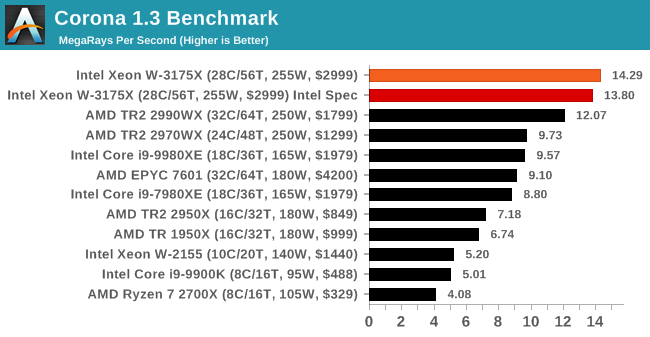
.
Blender 2.79b: 3D Creation Suite
A high profile rendering tool, Blender is open-source allowing for massive amounts of configurability, and is used by a number of high-profile animation studios worldwide. The organization recently released a Blender benchmark package, a couple of weeks after we had narrowed our Blender test for our new suite, however their test can take over an hour. For our results, we run one of the sub-tests in that suite through the command line - a standard ‘bmw27’ scene in CPU only mode, and measure the time to complete the render.
Blender can be downloaded at https://www.blender.org/download/
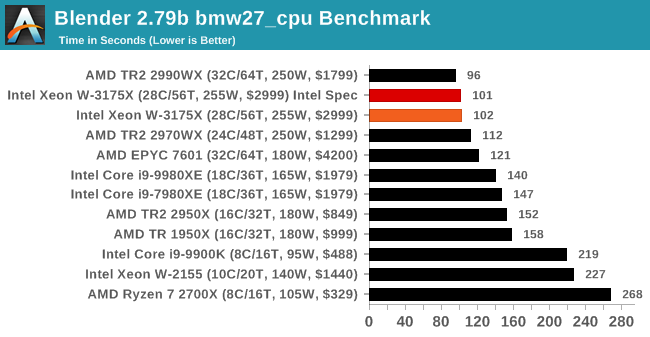
.
LuxMark v3.1: LuxRender via Different Code Paths
As stated at the top, there are many different ways to process rendering data: CPU, GPU, Accelerator, and others. On top of that, there are many frameworks and APIs in which to program, depending on how the software will be used. LuxMark, a benchmark developed using the LuxRender engine, offers several different scenes and APIs.
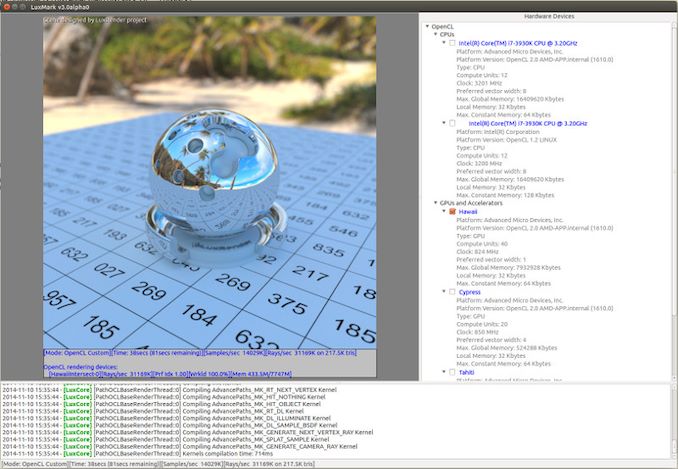
Taken from the Linux Version of LuxMark
In our test, we run the simple ‘Ball’ scene on both the C++ and OpenCL code paths, but in CPU mode. This scene starts with a rough render and slowly improves the quality over two minutes, giving a final result in what is essentially an average ‘kilorays per second’.
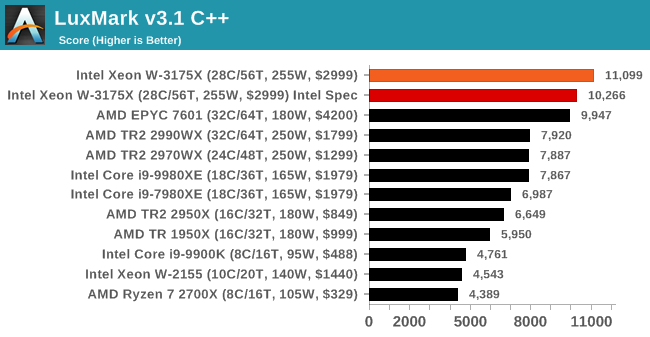
.
POV-Ray 3.7.1: Ray Tracing
The Persistence of Vision ray tracing engine is another well-known benchmarking tool, which was in a state of relative hibernation until AMD released its Zen processors, to which suddenly both Intel and AMD were submitting code to the main branch of the open source project. For our test, we use the built-in benchmark for all-cores, called from the command line.
POV-Ray can be downloaded from http://www.povray.org/
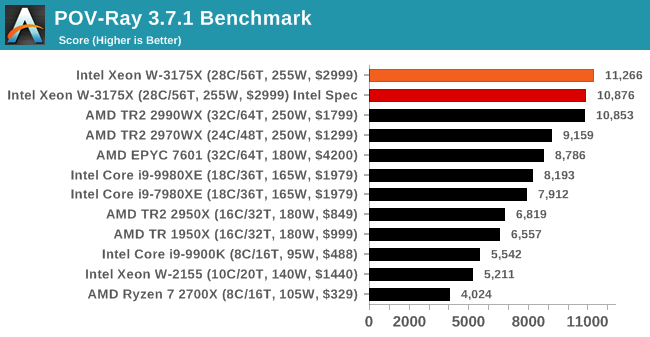
.











136 Comments
View All Comments
Icehawk - Thursday, January 31, 2019 - link
Yup. At the desktop level we have things like Adobe for $1k/seat/yr.Our big iron costs an order of magnitude more than these machines (recent orders were $150k ea and were mid-spec HP boxes). In the end most of the costs of a big server are memory and storage (SSDs). The high heat/energy consumption of this setup would be a concern, especially if in a colo.
jardows2 - Wednesday, January 30, 2019 - link
What are you rambling on about? It's a solid performing product, at a much reduced price than Intel's normal markup. I don't get where you come off thinking this is a fanboy post, and you totally missed my point - why is it limited to so few pieces? In Intel's lineup, it's a winner, and there are plenty of people in workstation markets who will only buy systems with Intel CPUs. So for Intel to make a good performing product, at a much lower than normal for Intel price, but only make a couple thousand of them? What's going on over there?edzieba - Thursday, January 31, 2019 - link
Because this is a cherry-picked part from a low-run die production. Intel don't make many XCC dies, and only a handful will be able to tolerate the high voltages and frequencies of this part across all 28 cores. It's also not going to be a big earner at $3000, that may break even on production but probably a loss overall when you take R&D into account.mapesdhs - Saturday, February 2, 2019 - link
A movie company I know buys systems in such bulk, a CPU/system like this wouldn't even show up on their radar. They prefer systems they can buy lots of, for multiple sites with a common setup.People are arguing here about A vs. B, about the CPU cost, but as many have pointed out it's often the sw cost and availability which determine what a company will purchase. As for workstation use, especially the prosumer market, that has its own set of issues, especially whether a particular app is written well enough to exploit so many cores. Blender is, but Premiere isn't.
FMinus - Friday, February 1, 2019 - link
Or you can get two TR 2970W system and make them work in tandem for what I would think would be almost half the price at this point, considering you can buy this Intel gem only pre-built for probably well bloated prices.SanX - Friday, February 1, 2019 - link
Intel are killing good at particle movement -- 4x faster then TR2. Till AMD makes AVX512 they are still dead for scienceET - Wednesday, January 30, 2019 - link
I find it amazing how application dependent performance is. Whether a product is a good buy depends so much on precisely what you're going to do with it, down to the application level.Still, on the whole, it looks like Intel has little to offer over AMD's much cheaper Threadripper platform.
BigMamaInHouse - Wednesday, January 30, 2019 - link
I think soon we gonna see "Leaks" about new TR64 cores, this "5GHZ 28C" stunt made AMD to release 2990WX instead just 24C 2970WX, now after the Fail attempt by Intel - We gonna see new leaks :-).FMinus - Friday, February 1, 2019 - link
Considering AMD was attending the same trade show, where Intel announced this 28 core chip and AMD a day later announced the new TR lineup, I'd say AMD planned to release the 2990WX regardless of what Intel had.mapesdhs - Saturday, February 2, 2019 - link
Yes, but the tinfoil hat industry is strong. :D